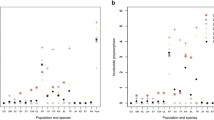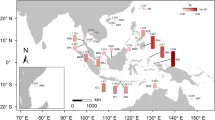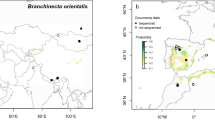Abstract
The Central American Isthmus (CAI) is an important geographic barrier in the Neotropics. Its role in the diversification of marine and coastal species has been detected in fishes, turtles, sea urchins, and mangroves. We evaluated the CAI’s influence on the diversification of the most ancient neotropical mangrove species Pelliciera rhizophorae across populations from the Caribbean and Pacific coasts, based on the analysis of ten nuclear microsatellite loci and two noncoding chloroplast DNA regions. The two molecular markers showed concordant patterns of diversification in this mangrove species. Contrary to our expectations, this study did not reveal significant genetic structure among populations separated by the CAI. Two major genetic variants (cluster I and cluster II) were found on both coasts, but the two were not found intermixed in the same population. Within each coastal region, breaking of gene flow among populations was found at two points in the Pacific Basin and one point in the Caribbean Basin, separating the Colombian and Panamanian populations. Our study revealed a transisthmian connection among populations of P. rhizophorae. This result, together with the reduced genetic diversity in the Caribbean reported in our previous study, suggests the recent origin of these populations, probably due to reintroduction of P. rhizophorae from the Pacific coast. Taking into account that these introductions are random events, this study raises a new question: Why are genetic variants not intermixed within the Caribbean populations? Our hypotheses suggest the influence of environmental factors and/or anthropogenic impact on the establishment of these Caribbean patches.




Similar content being viewed by others
References
Allen J (1998) Mangroves as alien species: the case of Hawaii. Global Ecol Biogeogr Lett 7:61–71
Bartlett A, Barghoorn E (1973) Phytogeographic history of the Isthmus of Panama during the past 12,000 years: a history of vegetation, climate, and sea-level change. In: Graham A (ed) Vegetation and vegetational history of Northern Latin America. Elsevier, Amsterdam, pp 203–300
Bowen BW, Clark AM, Abreu-Grobois FA, Chaves A, Reichart HA, Ferl RJ (1997) Global phylogeography of the ridley sea turtles (Lepidochelys spp.) as inferred from mitochondrial DNA sequences. Genetica 101:179–189
Bowen BW, Bass AL, Rocha LA, Grant WS, Robertson DR (2009) Phylogeography of the trumpetfishes (Aulostomus): ring species complex on a global scale. Evolution 55:1029–1039
Calderón-Saenz E (1984) Occurrence of the mangrove. Pelliciera rhizophorae TRIANA & PLANCHON, on the Caribbean coast of Colombia with biogeographical notes. Bull Mar Sci 35:105–110
Castaño A, Urrego L, Bernal G (2010) Dinámica del manglar en el complejo lagunar de Cispatá (Caribe colombiano) en los últimos 900 años. Rev Biol Trop 58:1347–1366
Castillo-Cárdenas MF, Toro-Perea N (2007) Development and characterization of the first microsatellite markers in the mangrove species Pelliciera rhizophorae Triana & Planchon. Mol Ecol Notes 7:1232–1234
Castillo-Cárdenas MF, Toro-Perea N, Cárdenas-Henao H (2005) Population genetic structure of neotropical mangrove species on the Colombian pacific coast: Pelliciera rhizophorae (Pellicieraceae). Biotropica 37:266–273
Castillo-Cárdenas MF, Díaz-Gonzales F, Toro-Perea N (2012) Low genetic diversity within Caribbean patches of Pelliciera rhizophorae, a neotropical mangrove species with reduced distribution. Aquat Bot 96:48–51
Ceron-Souza I, Rivera-Ocasio E, Medina E, Jimenez JA, McMillan WO, Bermingham E (2010) Hybridization and introgression in new world red mangroves, Rhizophora (Rhizophoraceae). Am J Bot 97:945–957
Ceron-Souza I, Bermingham E, McMillan WO, Jones FA (2012) Comparative genetic structure of two mangrove species in Caribbean and Pacific estuaries of Panama. BMC Evol Biol 12
Chapuis M-P, Estoup A (2007) Microsatellite null alleles and estimation of population differentiation. Mol Biol Evol 24:621–631
Chaves ME, Arango N (1997) Informe Nacional sobre el estado de la biodiversidad. Tomos I y II, Bogotá, Colombia
Coulon A, Fitzpatrick JW, Bowman R, Stith BM, Makarewich CA, Stenzler LM, Lovette IJ (2008) Congruent population structure inferred from dispersal behaviour and intensive genetic surveys of the threatened Florida scrub-jay (Aphelocoma coerulescens). Mol Ecol 17:1685–1701
Craig M, Hasting P, Pondella D (2004) Speciation in the Central American seaway: the importance of taxon sampling in the identification of trans-isthmian geminate pairs. J Biogeogr 31:1085–1091
de Bruyn M, Nugroho E, Hossain MM, Wilson JC, Mather PB (2004) Phylogeographic evidence for the existence of an ancient biogeographic barrier: the Isthmus of Kra seaway. Heredity 94:370–378
Dodd RS, Afzal-Rafii Z, Kashani N, Budrick J (2002) Land barriers and open oceans: effects on gene diversity and population structure in Avicennia germinans L. (Avicenniaceae). Mol Ecol 11:1327–1338
Duke N (1991) Nypa in the mangroves of Central America: introduced or relict? Principes 35:127–132
Duke NC (1995) Genetic diversity, distributional barriers and rafting continents—more thoughts on the evolution of mangroves. Hydrobiologia 295:167–181
Evanno G, Regnaut S, Goudet J (2005) Detecting the number of clusters of individuals using the software structure: a simulation study. Mol Ecol 14:2611–2620
Excoffier L, Laval G, Schneider S (2005) Arlequin (version 3.0): an integrated software package for population genetics data analysis. Evol Bioinforma 1:47–50
Goodman SJ (1997) RSTCalc: a collection of computer programs for calculating estimates of genetic differentiation from microsatellite data and determining their significance. Mol Ecol 6:881–885
Graham A (1975) Late Cenozoic evolution of tropical lowland vegetation in Veracruz México. Evolution 29:723–735
Graham A (1977) New records of Pelliciera (Theaceae/Pellicieraceae) in the tertiary of the Caribbean. Biotropica 9:48–52
Graham A, Jarzen D (1969) Studies in neotropical paleobotany. I. The Oligocene communities of Puerto Rico. Ann Mo Bot Gard 56:308–357
Hardy OJ, Vekemans X (2002) SPAGeDi: a versatile computer program to analyse spatial genetic structure at the individual or population levels. Mol Ecol Notes 2:618–620
Hua X, Wiens JJ (2013) How does climate influence speciation? Am Nat 182:1–12. doi:10.1086/670690
Jiménez JA (1984) A hypothesis to explain the reduced distribution of the mangrove Pelliciera rizhophorae Tr. & Pl. Biotropica 16:304–308
Kam Y, Schloder C, Roche DG, Torchin ME (2011) The Iraqi crab, Elamenopsis kempi in the Panama Canal: distribution, abundance and interactions with the exotic North American crab, Rhithropanopeus harrisii. Aquat Invasions 6:439–445
Keller B, Jackson J (1991) Long-term assessment of the oil spill at Bahia Las Minas, Panama. U.S. Department of the Interior Minerals Management Service Gulf of Mexico OCS Region, New Orleans
Knowlton N (2003) Sibling species in the sea. Annu Rev Ecol Syst 24:189–216. doi:10.1146/annurev.es.24.110193.001201
Knowlton N, Weigt L, Solorzano L, Mills D, Bermingham E (1993) Divergence in proteins, mitochondrial-DNA, and reproductive compatibility across the Isthmus of Panama. Science 260:1629–1632
Langenheim J, Hackner B, Bartlett A (1967) Mangrove pollen at the depositional site of Oligo-Miocene amber from Chiapas Mexico. Bot Mus Leafl Harv Univ 21:289–324
Leigh EG, O’Dea A, Vermeij GJ (2014) Historical biogeography of the Isthmus of Panama. Biol Rev 89:148–172
Lessios HA (2008) The great American schism: divergence of marine organisms after the rise of the Central American Isthmus. Annu Rev Ecol Evol Syst 39(Lessios HA):63–91. doi:10.1146/annurev.ecolsys.38.091206.095815
Lessios HA, Kessing BD, Robertson DR, Paulay G (1999) Phylogeography of the pantropical sea urchin Eucidaris in relation to land barriers and ocean currents. Evolution 53:806–817
Lessios HA, Kessing BD, Pearse JS (2001) Population structure and speciation in Tropical Seas: global phylogeography of the sea urchin Diadema. Evolution 55:955–975
Liao P-C, Havanond S, Huang S (2007) Phylogeography of Ceriops tagal (Rhizophoraceae) in Southeast Asia: the land barrier of the Malay Peninsula has caused population differentiation between the Indian Ocean and South China Sea. Conserv Genet 8:89–98
Librado P, Rozas J (2009) DnaSP v5: a software for comprehensive analysis of DNA polymorphism data. Bioinformatics 25:1451–1452
Lorente M (1986) Palynology and palynofacies of the upper tertiary in Venezuela. Diss Bot 99:1–222
Maddison W, Maddison D (2005) MacClade version 4.1. Sinauer, Sunderland
McCartney MA, Keller G, Lessios HA (2000) Dispersal barriers in tropical oceans and speciation in Atlantic and eastern Pacific sea urchins of the genus Echinometra. Mol Ecol 9:1391–1400
Miura O, Torchin ME, Bermingham E (2010) Molecular phylogenetics reveals differential divergence of coastal snails separated by the Isthmus of Panama. Mol Phylogenet Evol 56:40–48
Miura O, Torchin ME, Bermingham E, Jacobs DK, Hechinger RF (2012) Flying shells: historical dispersal of marine snails across Central America. Proc R Soc B Biol Sci 279:1061–1067
Montes C et al (2012) Evidence for middle Eocene and younger land emergence in central Panama: implications for Isthmus closure. Geol Soc Am Bull 124:780–799
Muss A, Ross Robertson D, Stepien CA, Wirtz P, Bowen BW (2009) Phylogeography of Ophioblennius: the role of ocean currents and geography in reef fish evolution. Evolution 55:561–572
Nettel A, Dodd RS (2007) Drifting propagules and receding swamps: genetic footprints of mangrove recolonization and dispersal along tropical coasts. Evolution 61:958–971
Nettel A, Dodd RS, Afzal-Rafii Z, Tovilla H, Ndez C (2008) Genetic diversity enhanced by ancient introgression and secondary contact in East Pacific black mangroves. Mol Ecol 17:2680–2690
Nuñez-Farfán J, Dominguez C, Eguiarte L, Cornejo A, Quijano M, Vargas J, Dirzo R (2002) Genetic divergence among Mexican populations of red mangrove (Rhizophora mangle): geographic and historic effects. Evol Ecol Res 4:1049–1064
Paiva MR, Santos H, Kerdelhue C, Mateus EP, M.R. B (2011) Can climate changes drive speciation? Paper presented at the Proceedings of the Global Conference on Global Warming, Lisbon, Portugal
Pares-Regali M, Uesungli N, Santos R (1974) Palinologia dos sedimentos meso-cenozoicas do Brasil Boletin Tecnico Petrobras 17:177–191
Peakall R, Smouse PE (2006) GenAlEx 6: genetic analysis in Excel. Population genetic software for teaching and research. Mol Ecol Notes 6:288–295
Phillips S, Rouse GE, Bustin RM (1997) Vegetation zones and diagnostic pollen profiles of a coastal peat swamp, Bocas del Toro, Panamá. Palaeogeogr Palaeoclimatol Palaeoecol 128:301–338
Pons O, Petit RJ (1996) Measuring and testing genetic differentiation with ordered versus unordered alleles. Genetics 144:1237–1245
Prahl H von (1987) Notas sobre la historia natural del mangle piñuelo Pelliciera rhizophorae (Theaceae) en el Pacífico Colombiano. Actualidades Biológicas 15:117–122
Pritchard JK, Stephens M, Donnelly P (2000) Inference of population structure using multilocus genotype data. Genetics 155:945–959
Rabinowitz D (1978) Dispersal properties of mangrove propagules. Biotropica 10:47–57
Roth LGA (1991) New record of the mangrove Pelliciera rhizophorae (Theaceae) on the Caribbean Coast of Nicaragua Rhodora 93:183
Rousset F (2008) GENEPOP’007: a complete implementation of the GENEPOP software for Windows and Linux. Mol Ecol Resour 8:103–106
Rull V (1998) Evolución de los manglares neotropicales: la crisis del Eoceno. Interciencia 23:355–362
Saenger P (1998) Mangrove vegetation: an evolutionary perspective. Mar Freshw Res 49:277–286
Saenger P (2002) Mangrove ecology, silviculture and conservation. Kluwer Academic Publishers, Dordrecht
Saenger P, Bellan MF (1995) The mangrove vegetation of the Atlantic coast of Africa: a review Laboratoire d’écologie terrestre, Centre national de la recherche scientifique, Université de Toulouse III
Sanchez-Paez H, Alvarez-León R, Pinto-Nolla F, Sanchez-Alférez A, Pino-Rengifo J, García-Hansen I, Acosta-Peñalosa M (1997) Diagnóstico y Zonificación de los manglares del Caribe colombiano. Proyecto conservación y Manejo para el uso múltiple y el desarrollo de los manglares en Colombia. Ministerio del Medio Ambiente, Organización Internacional de Maderas Tropicales (OIMT). Bogotá, Colombia
Shaw J, Lickey EB, Schilling EE, Small RL (2007) Comparison of whole chloroplast genome sequences to choose noncoding regions for phylogenetic studies in angiosperms: the tortoise and the hare III. Am J Bot 94:275–288
Tajima F (1989) Statistical method for testing the neutral mutation hypothesis by DNA polymorphism. Genetics 123:585–595
Takayama K, Tamura M, Tateishi Y, Webb EL, Kajita T (2013) Strong genetic structure over the American continents and transoceanic dispersal in the mangrove genus Rhizophora (Rhizophoraceae) revealed by broad-scale nuclear and chloroplast DNA analysis. Am J Bot 100:1191–1201. doi:10.3732/ajb.1200567
Tomlinson PB (1994) The botany of mangroves, 1 pbkth edn, Cambridge tropical biology series. Cambridge University Press, Cambridge
Urrego LE, Bernal G, Polanía J (2009) Comparison of pollen distribution patterns in surface sediments of a Colombian Caribbean mangrove with geomorphology and vegetation. Rev Palaeobot Palynol 156:358–375
Van der Hammen T, Wijmstra T (1964) A palynological study on the tertiary and upper cretaceous of British Guiana. Leid Geol Meded 30:183–241
Wijmstra T (1968) The identity of Psitricolporites and Pelliciera. Acta Bot Neerlandica 17:114–116
Winograd M (1983) Observaciones sobre el hallazgo de Pelliciera rhizophorae (Theaceae) en el Caribe colombiano. Biotropica 15:297–298
Acknowledgments
We are grateful to Universidad del Valle (Colombia) for institutional support, to the International Foundation for Science (IFS) for financial support, grant no. D-3238, and to Smithsonian Tropical Research Institute (STRI) in Panama for logistical and financial support in field and laboratory work. For collaboration in field work, we are grateful to “Molecular Biology and Ecogenetic Studies Team” (Universidad del Valle) in Colombia, Biol. O. López (STRI) in Panama, Ing. A. Bodero and Ing. AC. Ceballos in Ecuador, Lianna Mora and Biol. Albert Rojas from Organización de Estudios Tropicales (OTS) in Costa Rica.
Data archiving statement
All chloroplast haplotypes reported in this study have been deposited at Genbank:
psbJ-petA GenBank accession numbers: HM461568, HM461569, HM461570
psbD-trnT GenBank accession numbers: HM461571, HM461572, HM461573, HM461574
Author information
Authors and Affiliations
Corresponding author
Additional information
Communicated by Y. Tsumura
Electronic supplementary material
Below is the link to the electronic supplementary material.
ESM 1
Population structure of P. rhizophorae obtained by STRUCTURE from microsatellite data. True number of clusters (K) calculated by Bayesian algorithm (500,000 replicates of MCMC after a burn-in of 50,000). The likelihood of K was analyzed from K = 1 to K = 5 using 20 runs for each K value. (PDF 55 kb)
Rights and permissions
About this article
Cite this article
Castillo-Cárdenas, M.F., Díaz-Gonzales, F., Cerón-Souza, I. et al. Jumping a geographic barrier: diversification of the mangrove species Pelliciera rhizophorae (Tetrameristaceae) across the Central American Isthmus. Tree Genetics & Genomes 11, 822 (2015). https://doi.org/10.1007/s11295-014-0822-1
Received:
Revised:
Accepted:
Published:
DOI: https://doi.org/10.1007/s11295-014-0822-1




